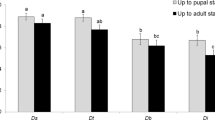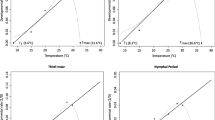Abstract
Stem borer Stromatium barbatum has recently emerged as a serious pest problem of grapevines in India. Hidden biology and lack of effective chemical control of stem borer warranted finding out weak links in its life cycle which aids in formulating effective management strategies. Being a monovoltine pest with annual life cycle, the systematic studies on developmental biology and stage specific mortality of stem borer in grapes are limited. In present study, a cohort life table was constructed for S. barbatum by rearing it on grapevine wood logs in the laboratory at 27 ± 1 ℃ temperature and 65 ± 5% RH. The life cycle of S. barbatum was tracked from egg hatching through larval and pupal stages till adult emergence and observations were recorded on stage specific developmental durations and mortality of immature stages, and longevity and fecundity of adult stages. The results revealed that the mean durations of egg, larvae and pupae were 6.60 ± 0.28 days, 296.10 ± 1.06 days and 19.70 ± 1.17 days, respectively. The adults after emerging from pupae could survive up to 36.40 ± 0.81 days. The egg hatching and adult emergence from pupae were 42.51% and 83.02%, respectively. S. barbatum population attained a net reproductive rate of 64.96 females/female/generation and a gross reproductive rate of 72.93 females/female/generation in her mean oviposition period of 9.80 ± 0.13 days. The data indicated that, S. barbatum population potentially might increase with an intrinsic rate (rm) of 0.087 females/female/day and a finite rate \((\lambda )\) of 1.09 females/ female/ day with a doubling time of 9.98 days and a mean generation time of 324.30 days. The mortality was relatively higher during the egg and larval stages, which was then gradually decreased for rest of the life span when S. babatum was reared on grapevine wood logs under laboratory conditions. Generation mortality for S. barbatum was 90.72%. The present study has generated detailed information on critical life events such as days to egg hatch, adult longevity and fecundity, time required for adults to oviposit after mating, and age-stage specific mortality. This could facilitate formulation and implementation of effective management strategies for S. barbatum in grape vineyards.
Similar content being viewed by others
References
Andrewartha HG, Birch LC (1954) The innate capacity for increase in numbers. In: The distribution and abundance of Animals. 3rd impression, University of Chicago, pp. 31–54.
Beeson CFC (1941) The Ecology and Control of the Forest Insects India the neighboring Countries (1961 reprint). Govt. of India, New Delhi
Beeson C, FC, Bhatia BM (1939) On the biology of the Cerambycidae (Coleopt.). Indian Forest Records (new series): Entomology 5: 1–235.
Goodwin S (2005) A new strategy for the chemical control of fig longicorn, Acalolepta vastator (Newman) (Coleoptera: Cerambycidae), infesting grapevines. Aust J Entomol 44(2):170–174
ICAR-NRCG (2018b) Annexure-5. List of chemicals with CIB and RC label claim for use in grapes, Revised on 24th September, 2018. ICAR-National Research Centre for Grapes, Pune, Maharashtra, India. Available online at: https://nrcgrapes.icar.gov.in/zipfiles/Annexure%205.pdf. Accessed on 26 Apr 2019.
ICAR-NRCG (2015) Annual Report 2014–15. ICAR-National Research Centre for Grapes, Pune., p 101
ICAR-NRCG (2017) Annual Report 2016–17. ICAR-National Research Centre for Grapes, Pune., p 144
ICAR-NRCG (2018a) Annual Report 2017–18. ICAR-National Research Centre for Grapes, Pune, Maharashtra, India – 412 307, pp.146.
Jervis MA, Copland MJW, Harvey JA (2005) The life cycle. In: Jervis MA (ed) Insects as natural enemies, a practical perspective. Springer, Dordrecht The Netherlands, pp 140–192
Khan TN, Maiti PK (1983) Studies on the biotaxonomy, biology and ecology of some longicorn beetle borers (Coleoptera cerambycidae) of the islands of andaman, India. Printed at The Elm Press, 63 Beadon Street, Calcutta-6 and Published by the Director, Zoological Survey of India, Calcutta. Occasional paper no. 45
Koutroumpa FA, Vincent B, Roux-Morabito G, Martin C, Lieutier F (2008) Fecundity and larval development of Monochamus galloprovincialis (Coleoptera Cerambycidae) in experimental breeding. Annals of Forest Science 65: 707. https://doi.org/10.1051/forest:2008056.
Mani M, Shivaraju C, Kulkarni NS (2013) The Grape Entomology. Springer Science and Business Media, pp. 202. https://doi.org/10.1007/978-81-322-1617-9.
NHM (2017) Horticultural statistics at a glance – 2017. National Horticulture Board, Horticultural Statistics Division, Department of Agriculture and Farmers Welfare, Ministry of Agriculture and Farmers Welfare Government of India, Government of India.
Parihar DR, Singh MP (1993) Insects associated with Prosopis cineraria in arid western Rajasthan, India. In: Proceedings of a conference held at the Central Arid Zone Research Institute, Jodhpur, Rajasthan, India. November 21–23.
Powell W (1982) Age-specic life-table data for the Eucalyptus boring beetle, Phoracantha semipunctata (F.) (Coleoptera: Cerambycidae), in Malawi. Bull Entomol Res 72:645–653
Rogers CE (1977) Bionomics of Oncideres cingulata (Coleoptera: Cerambycidae) on Mesquite. J Kansas Entomol Soc 50(2):222–228
Salini and DS Yadav (2011) Occurrence of Stromatium barbatum (Fabr.) (Coleoptera: Cerambycidae) on grapevine in Maharashtra, India. Pest Management in Horticultural Ecosystems, Vol. 17, No. 1 pp 48–50
Southwood TRE (1966) Ecological Methods, with particular reference to the study of insect populations. Methuen and Co., Ltd, London, p 390
Wang Q (2017) Cerambycidae of the world: biology and pest management. CRC Press, Taylor and Francis Group, Boca Raton, Florida, p 643
Yadav DS and Amala U (2013) Insect and mite pest management, pp 38–46. In: Adsule PG, Yadav DS, Upadhyay A, Satisha J and Sharma AK (Editors), 2013. Good agricultural practices for production of table grapes. ICAR-National Research Center for Grapes, Pune, Maharashtra, India – 412 307, 138 p.
Yadav DS, Ranade YH, Samarth RR, Fand BB (2019) Cytology of stem borer Stromatium barbatum (F.) infesting grapevines in Maharashtra. Indian Journal of Entomology 81 (1): 170–176.
Zhao RL, Lu ZS, Lu XH, Wu XY (1993) Life table study of Anoplophora glabripennis (Coleoptera: Cerambycidae) natural populations. Journal of Beijing Forestry University 15(4):125–129
Acknowledgement
This study is a part of the research project titled “Management of stem borer in grapes (Project Code-IXX10000)” of ICAR-National Research Centre for Grapes (ICAR-NRCG), Pune (Maharashtra, India). The authors gratefully acknowledge financial support from Indian Council of Agricultural Research, New Delhi. We are thankful to the Director, ICAR-NRCG for providing all the necessary facilities and extending his cooperation and support to carry out present investigations.
Author information
Authors and Affiliations
Corresponding author
Ethics declarations
Conflict of Interest
The authors declare that they have no conflict of interest.
Rights and permissions
About this article
Cite this article
Fand, B.B., Yadav, D.S., Mhaske, S.H. et al. Biological parameters of stem borer Stromatium barbatum reared on grapevine wood logs under laboratory conditions. Int J Trop Insect Sci 41, 2795–2803 (2021). https://doi.org/10.1007/s42690-021-00460-4
Received:
Accepted:
Published:
Issue Date:
DOI: https://doi.org/10.1007/s42690-021-00460-4




